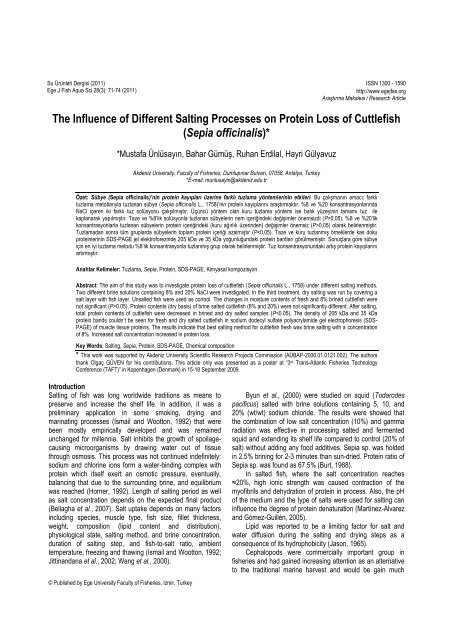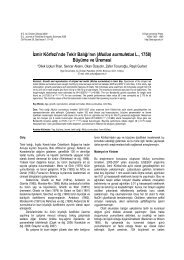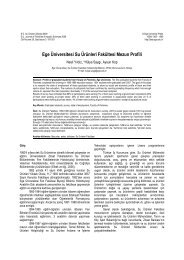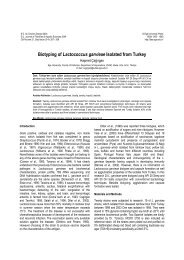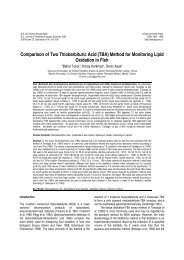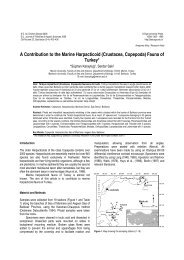Sepia officinalis - Journal of Fisheries and Aquatic Sciences
Sepia officinalis - Journal of Fisheries and Aquatic Sciences
Sepia officinalis - Journal of Fisheries and Aquatic Sciences
You also want an ePaper? Increase the reach of your titles
YUMPU automatically turns print PDFs into web optimized ePapers that Google loves.
Su Ürünleri Dergisi (2011) ISSN 1300 - 1590<br />
Ege J Fish Aqua Sci 28(3): 71-74 (2011)<br />
http://www.egejfas.org<br />
Araştırma Makalesi / Research Article<br />
The Influence <strong>of</strong> Different Salting Processes on Protein Loss <strong>of</strong> Cuttlefish<br />
(<strong>Sepia</strong> <strong><strong>of</strong>ficinalis</strong>)*<br />
*Mustafa Ünlüsayın, Bahar Gümüş, Ruhan Erdilal, Hayri Gülyavuz<br />
Akdeniz University, Faculty <strong>of</strong> <strong>Fisheries</strong>, Dumlupınar Bulvarı, 07058, Antalya, Turkey<br />
*E-mail: munlusayin@akdeniz.edu.tr<br />
Özet: Sübye (<strong>Sepia</strong> <strong><strong>of</strong>ficinalis</strong>)’nin protein kayıpları üzerine farklı tuzlama yöntemlerinin etkileri. Bu çalışmanın amacı; farklı<br />
tuzlama metotlarıyla tuzlanan sübye (<strong>Sepia</strong> <strong><strong>of</strong>ficinalis</strong> L., 1758)’nin protein kayıplarını araştırmaktır. %8 ve %20 konsantrasyonlarında<br />
NaCl içeren iki farklı tuz solüsyonu çalışılmıştır. Üçüncü yöntem olan kuru tuzlama yöntemi ise balık yüzeyinin tamamı tuz ile<br />
kaplanarak yapılmıştır. Taze ve %8’lik solüsyonla tuzlanan sübyelerin nem içeriğindeki değişimler önemsizdi (P>0,05). %8 ve %20’lik<br />
konsantrasyonlarla tuzlanan sübyelerin protein içeriğindeki (kuru ağırlık üzerinden) değişimler önemsiz (P>0,05) olarak belirlenmiştir.<br />
Tuzlamadan sonra tüm gruplarda sübyelerin toplam protein içeriği azalmıştır (P0.05). Protein contents (dry basis) <strong>of</strong> brine salted cuttlefish (8% <strong>and</strong> 20%) were not significantly different. After salting,<br />
total protein contents <strong>of</strong> cuttlefish were decreased in brined <strong>and</strong> dry salted samples (P
72<br />
Ünlüsayın et al., Ege J Fish Aqua Sci 28(3): 71-74 (2011)<br />
larger importance in the future to supply mankind with marine<br />
living resources (Piatowski et al., 2001). Total cephalopod<br />
l<strong>and</strong>ings were increased steadily since 1950s (FAO, 2005).<br />
The aim <strong>of</strong> the preset study was to determine the effects<br />
<strong>of</strong> salting on cuttlefish flesh as a preprocessing before smoked<br />
<strong>and</strong> also the protein loss <strong>of</strong> species with different salting<br />
methods. Determination <strong>of</strong> the best salting method as a<br />
preliminary application for processing was crucial to avoid<br />
nutrient loss.<br />
Materials <strong>and</strong> Methods<br />
Common cuttlefish (<strong>Sepia</strong> <strong><strong>of</strong>ficinalis</strong> L., 1758) was used for<br />
this investigation. Cuttlefish were gillnetted with local<br />
fisherman from Boğazkent, (Serik-Antalya, Turkey) in April-<br />
2007. Mean total body mass <strong>and</strong> mantle length <strong>of</strong> individuals<br />
were 98.6±17.7 g <strong>and</strong> 9.2±0.5 cm, respectively. Samples<br />
were then transported to laboratory in polystyrene boxes in<br />
crushed ice during approximately 60 min. Totally, for<br />
treatments <strong>of</strong> 30 common cuttlefish each were used for 4<br />
different treatments.<br />
The viscera, head <strong>and</strong> arms <strong>of</strong> the cuttlefishes were<br />
removed <strong>and</strong> mantles were washed with water. Salt, also<br />
known as rock salt, is a crystalline mineral that is composed<br />
primarily <strong>of</strong> sodium chloride (NaCl) <strong>and</strong> that used for salting<br />
process was purchased from local market (Antalya). The salt<br />
processes (salt concentration, ratio <strong>of</strong> cuttlefish to brine) were<br />
chosen based on seafood industrial practices <strong>of</strong> the firms<br />
(Antalya-Turkey) as follows. Brine salting <strong>and</strong> dry salting<br />
processes were conducted in plastic containers at 4±1ºC. The<br />
concentrations <strong>of</strong> salt in brine solutions were 8% (R) <strong>and</strong> 20%<br />
(W) (w/w), <strong>and</strong> curing processes using these brine<br />
concentrations with a fish to brine ratio <strong>of</strong> 1:1 were carried out<br />
for a period <strong>of</strong> 6 h <strong>and</strong> 45 min respectively. Dry salting (D) was<br />
run for 12 h <strong>and</strong> salting process was carried by covering the<br />
surface <strong>of</strong> fish. Thereby squid was inserted into a salt layer.<br />
After the curing process salted mantles <strong>of</strong> the cuttlefishes<br />
were then used for the analysis. Unsalted fish were used as<br />
control. pH was measured in the dorsal muscle with a digital<br />
electronic pH meter with a glass electrode (WTW Mark, 320,<br />
Germany).<br />
The chemical contents <strong>of</strong> common cuttlefish flesh <strong>and</strong><br />
extract were determined according to Official Methods <strong>of</strong><br />
Analysis. Moisture contents were in fish flesh determined<br />
according to method 950.46 (AOAC, 2002a). Crude protein<br />
content (Nx6.25) was calculated using the Kjeldahl method<br />
(AOAC, 2002b). Lipid (fat) content was determined according<br />
to Soxhlet method (AOAC, 2002c). Crude ash (Inorganic<br />
matter in meat) was determined according to method 920.153<br />
(AOAC, 2002d). Sodium chloride was determined by<br />
volumetric method (AOAC, 1995). Solid matter in extract was<br />
determined according to Gravimetric method 952.08 (AOAC,<br />
2002a). After the water in extract was removed, crude ash in<br />
extract was calculated according to method Official Methods<br />
<strong>of</strong> Analysis (AOAC, 2002d) <strong>and</strong> the organic matter in extract<br />
was calculated by using the following formula:<br />
Organic matter in extract (%) = 100 – Crude ash in extract.<br />
A total <strong>of</strong> 1.5 g minced muscle tissue <strong>of</strong> cuttlefish were<br />
homogenised at 4°C for 1 min in 9.5 ml physiological saline<br />
(0.9% NaCl) with a mechanical homogenizer (Heidolph, Slient<br />
Crusher M model, Heidolph Instruments GmbH & Co KG,<br />
Germany), dialled to setting 6. Samples were stirred<br />
constantly for 20 min at 2°C then centrifuged at 5000 rpm for<br />
25 minutes at 4°C in an Elektromag (4808p, İkitelli OSB,<br />
İstanbul, Turkey). Protein concentration was determined in the<br />
supernatant by kit method (Lowry et al., 1951), (Protein<br />
Determination without Protein Precipitation Procedure; Sigma,<br />
Code TP0300 <strong>and</strong> L3540). Optical density was measured at<br />
650 nm in Chebios UV/ spectrophotometer (Optimum-One,<br />
Chebios s.r.l., Roma, Italy). The remainder <strong>of</strong> the supernatant<br />
was freeze-dried <strong>and</strong> kept at -18°C for further analysis.<br />
Discontinuous PAGE was prepared dilution <strong>of</strong> a 30%<br />
stock solution <strong>of</strong> acrylamide where the total amount (T) <strong>of</strong><br />
acrylamide+bis was 2% for the stacking gel <strong>and</strong> 5.1% for<br />
resolving gel. Freeze dried protein samples were reconstituted<br />
in Laemmli (1970) sample buffer to achieve the protein<br />
concentration <strong>of</strong> 13 microgram/microliter <strong>and</strong> loaded in each<br />
well <strong>of</strong> the gels. Electrophoresis (Mini-Protean II/Bio-Rad) was<br />
carried out at 35 mA one slab until the tracking dye reached<br />
the bottom <strong>of</strong> the gel (3h) in chamber with cooling to<br />
approximately 10°C. The molecular weight <strong>of</strong> each protein<br />
b<strong>and</strong> could then be calculated according to the st<strong>and</strong>ard curve<br />
<strong>of</strong> purified wide range marker proteins including aprotinin,<br />
bovine lung (6.5 kDa), α-lactalbumin, bovine milk (14.2 kDa),<br />
trypsin inhibitor, soybean (20 kDa), trypsinogen, bovine<br />
pancreas (24 kDa), carbonic anhydrase, bovine erythrocytes<br />
(29 kDa), glyceraldehyde-3-phosphate dehydrogenase, rabbit<br />
muscle (36 kDa), ovalbumin, chicken egg (45 kDa), glutamic<br />
dehydrogenase, bovine liver (55 kDa), albumin, bovine serum<br />
(66 kDa), phosphorylase B, rabbit muscle (97 kDa), β-<br />
galactosidase, E. coli (116 kDa), myosin, rabbit muscle (205<br />
kDa) from Sigma (Cat. No: M. S8445). Following<br />
electrophoresis, gels were stained with 0.04 % comassie blue<br />
R-250 in 2-propanol: acetic acid: water (25:10:65) overnight at<br />
room temperature. Excess stain was removed with several<br />
washes <strong>of</strong> the same solution without comassie blue R-250.<br />
Picture <strong>of</strong> them were taken in 7% acetic acid while they were<br />
still wet.<br />
Statistical analyses were performed using “SPSS 10.0 for<br />
Windows s<strong>of</strong>tware” (SPSS Inc, Chicago, IL). Differences in the<br />
means between groups were analysed by one-way ANOVA.<br />
Two-tailed P values were used, <strong>and</strong> statistical significance<br />
was set to P
The influence <strong>of</strong> different salting processes on protein loss <strong>of</strong> cuttlefish (<strong>Sepia</strong> <strong><strong>of</strong>ficinalis</strong>) 73<br />
fresh cuttlefish reported by Özoğul et al., (2008) were<br />
81.02±0.18% in spring, 78.02±0.21% in autumn, <strong>and</strong> 79.51 ±<br />
0.28% in winter. Özoğul (2012) also reported mantle <strong>of</strong><br />
cuttlefish caught from the Gulf <strong>of</strong> Mersin had high protein<br />
(22.20% for female <strong>and</strong> 22.15% for male) <strong>and</strong> low fat contents<br />
(0.86% for female <strong>and</strong> 1.01% for male). Zlatanos et al., (2006)<br />
reported moisture content <strong>of</strong> 81.2±2.0%. Changes in protein<br />
content <strong>of</strong> cuttlefish salted with 8% <strong>and</strong> 20% salt were similar<br />
<strong>and</strong> after the salting process, the crude protein content<br />
decreased than the fresh samples, owing to the muscle<br />
protein lost into the extract. Loss <strong>of</strong> protein for dry salted<br />
samples is more than brine salted samples (Table 1). The lipid<br />
content <strong>of</strong> species was found to be very low <strong>and</strong> species was<br />
all considered as lean. The results indicate that this<br />
cephalopod species is excellent protein sources <strong>and</strong> has low<br />
fat content. These results are supported by the findings <strong>of</strong><br />
other researchers (Özoğul et al., 2008; Zlatanos et al., 2006).<br />
Because <strong>of</strong> the low lipid content <strong>of</strong> cuttlefish meat, changes in<br />
lipid content after salting were insignificant (P>0.05).<br />
Table 1. Chemical composition <strong>of</strong> cuttlefish samples<br />
Part <strong>of</strong> cuttlefish Analysis OC OR OW OD<br />
Moisture (%) 77.40±0.25 a 76.36±0.42 a 73.04±1.02 b 67.62±1.47 c<br />
Dry Matter (%) 22.60±0.25 c 23.64±0.42 c 26.96±1.02 b 32.38±1.47 a<br />
Protein (%) 84.81±2.49 a 73.90±2.42 b 72.81±6.23 b 54.92±2.07 c<br />
Flesh Lipid (%) 5.65±1.94 a 4.66±1.25 a 5.71±1.77 a 3.86±0.43 a<br />
Ash (%) 7.19±2.13 b 18.52±2.20 a 16.48±2.21 a 19.03±1.11 a<br />
pH 6.75±0.13 a 6.44±0.09 b 6.60±0.07 ab 6.45±0.20 b<br />
NaCl (%) ― 14.56±1.19 b 15.15±0.63 b 17.40±0.66 a<br />
Solid Matter (%) ― 6.66±1.24 b 16.75±0.24 a 8.25±2.08 b<br />
Extract Inorganic Matter (%) ― 12.01±2.79 b 20.67±4.58 a 19.28±1.13 a<br />
Lipid (%) ― 1.02±0.07 a 1.01±0.05 a 0.98±0.06 a<br />
Values are shown as mean ± st<strong>and</strong>ard deviation <strong>of</strong> triplicate measurements.<br />
Different superscript letters in the same row indicate significant differences between groups (P
74<br />
Ünlüsayın et al., Ege J Fish Aqua Sci 28(3): 71-74 (2011)<br />
Figure 1. SDS-PAGE <strong>of</strong> muscle proteins <strong>of</strong> fresh, brine salted <strong>and</strong> dry salted<br />
cuttlefish samples.<br />
OC; Fresh cuttlefish., OR; Brine salted 8% (w/w) cuttlefish meat OW; Brine<br />
salted 20% (w/w) cuttlefish meat, OD; Dry salted cuttlefish meat<br />
Electrophoretic pr<strong>of</strong>iles <strong>of</strong> proteins released into various<br />
cuttlefish samples were shown in Figure 1. The density <strong>of</strong> 205<br />
kDa <strong>and</strong> 36 kDa protein b<strong>and</strong>s couldn’t be seen for both fresh<br />
<strong>and</strong> dry salted cuttlefish. All the other protein b<strong>and</strong>s (150, 118,<br />
106, 67, 48, 38 <strong>and</strong> 31) can be seen for all brine methods. In<br />
this respect, protein b<strong>and</strong>ing patterns <strong>of</strong> different salted<br />
samples <strong>of</strong> cuttlefish resembled each other.<br />
Conclusion<br />
Salting process with 8% brine seems to be the best for<br />
cuttlefish samples because <strong>of</strong> the minimum loss <strong>of</strong> organic<br />
material. For both brining with 20% solution <strong>and</strong> dry salting,<br />
organic material losses have been determined. Although<br />
protein content changed depending on the concentration <strong>of</strong><br />
salt solution lipid content did not change. Our results may<br />
imply that the increase in salt concentration was effective in<br />
respect <strong>of</strong> the extract loss <strong>of</strong> common cuttlefish. Low lipid<br />
content <strong>of</strong> cuttlefish meat causes more water loss <strong>and</strong> salt<br />
diffusion at salt concentrations. Consequently we don’t<br />
recommend salting with high salt concentrations as a<br />
preliminary operation for processing for cephalopod species.<br />
References<br />
Association <strong>of</strong> Official Analytical Chemists. 1995. Salt (Chlorine as Sodium<br />
Chloride) in Meat. 935.47. Official methods <strong>of</strong> analysis (15 th edition).<br />
Gaithersburg. Maryl<strong>and</strong>.<br />
Association <strong>of</strong> Official Analytical Chemists. 2002a. Moisture content. 950.46.<br />
Official Methods <strong>of</strong> Analysis (17th edition). Gaithersburg. Maryl<strong>and</strong>.<br />
Association <strong>of</strong> Official Analytical Chemists. 2002b. Protein content in meat.<br />
928.08. Official Methods <strong>of</strong> Analysis (17th edition). Gaithersburg.<br />
Maryl<strong>and</strong>.<br />
Association <strong>of</strong> Official Analytical Chemists. 2002c. Fat content in meat.<br />
960.39. Official Methods <strong>of</strong> Analysis (17th edition). Gaithersburg.<br />
Maryl<strong>and</strong>.<br />
Association <strong>of</strong> Official Analytical Chemists. 2002d. Ashes content. 920.153.<br />
Official Methods <strong>of</strong> Analysis (17th edition). Gaithersburg. Maryl<strong>and</strong>.<br />
Bellagha, S., Sahli, A., Farhat, A., Kechaou, N., Glenza, A. 2007. Studies on<br />
salting <strong>and</strong> drying <strong>of</strong> sardine (Sardinella aurita): Experimental kinetics<br />
<strong>and</strong> modelling. <strong>Journal</strong> <strong>of</strong> Food Engineering, 78:947-952.<br />
Burt, J.R. 1988. Fish Smoking <strong>and</strong> Drying. Elsevier Science Publishers Ltd.,<br />
London, Engl<strong>and</strong>.<br />
Byun, M.W., Lee, K.H., Kim, D.H., Kim, J.H., Yook, H.S., Ahn, H.J. 2000.<br />
Effects <strong>of</strong> gamma radiation on sensory qualities, microbiological <strong>and</strong><br />
chemical properties <strong>of</strong> salted <strong>and</strong> fermented squid. <strong>Journal</strong> <strong>of</strong> Food<br />
Protection, 63:934-939.<br />
FAO. 2005. The State <strong>of</strong> the World <strong>Fisheries</strong> <strong>and</strong> Aquaculture, 2005. FAO,<br />
Rome, Italy.<br />
Horner, W.F.A. 1997. Salting. In: Fish Processing Technology Preservation <strong>of</strong><br />
Fish by Curing, Hall, G.M. (ed). Chapman&Hall Publishers, UK, 32-72.<br />
Ismail, N., Wootton, M. 1992. Fish salting <strong>and</strong> drying: a review. Asian Food<br />
Joournal, 7:175-183.<br />
Jason, A.C. 1965. Effects <strong>of</strong> fat content on diffusion <strong>of</strong> water in fish muscle.<br />
<strong>Journal</strong> Science <strong>and</strong> Food Agricultural, 16:281-288.<br />
Jittin<strong>and</strong>ana, S., Kenney, P.B., Slider, S.D., Kiser, R.A. 2002. Effect <strong>of</strong> brine<br />
concentration <strong>and</strong> brining time on quality <strong>of</strong> smoked rainbow trout fillet.<br />
<strong>Journal</strong> <strong>of</strong> Food Science, 67:2095-2099.<br />
Laemmli, U.K. 1970. Cleavage <strong>of</strong> structural proteins during the assembly <strong>of</strong><br />
the heat <strong>of</strong> bacteriophage T4. Nature, 227:680-685.<br />
Lowry, O.H., Rosenbrough, N.J., Farr, A.L., R<strong>and</strong>all, R.J. 1951. Protein<br />
measurement with the folin phenol reagent. <strong>Journal</strong> <strong>of</strong> Biochemistry,<br />
193:265-275.<br />
Martínez-Alvarez, O., Gόmez-Guillén, M.C. 2005. The effect <strong>of</strong> brine<br />
composition <strong>and</strong> pH on the yield <strong>and</strong> nature <strong>of</strong> water-soluble proteins<br />
extractable from brined muscle <strong>of</strong> cod (Gadus morhua). Food<br />
Chemistry, 92:71-77.<br />
Martínez-Alvarez, O., Gόmez-Guillén, M.C. 2006. Effect <strong>of</strong> brine salting at<br />
different pHs on the functional properties <strong>of</strong> cod muscle proteins after<br />
subsequent dry salting. Food Chemistry, 94:123-129.<br />
Özoğul, Y., Duysak, O., Özoğul, F., Özkütük, A.S., Türeli, C. 2008. Seasonal<br />
effects in the nutritional quality <strong>of</strong> the body structural tissue <strong>of</strong><br />
cephalopods. Food Chemistry, 108:847-852.<br />
Özoğul, Y. 2012. The chemical composition <strong>and</strong> meat yield <strong>of</strong> sexually mature<br />
cuttlefish (<strong>Sepia</strong> <strong><strong>of</strong>ficinalis</strong>). <strong>Journal</strong> <strong>of</strong> <strong>Fisheries</strong> <strong>Sciences</strong>.com, 6(2):99-<br />
106.<br />
Piatowski, U., Pierce, G.J., Morais, D.A., Cunha, M. 2001. Impact <strong>of</strong><br />
cephalopods in the food chain <strong>and</strong> their interaction with the<br />
environment <strong>and</strong> fisheries. <strong>Fisheries</strong> Research, 52:5-10.<br />
Sannaveerappa, T., Ammu, K., Joseph, J. 2004. Protein-related changes<br />
during salting <strong>of</strong> milkfish (Chanos chanos). <strong>Journal</strong> <strong>of</strong> Science Food<br />
<strong>and</strong> Agricultural, 84:863-869.<br />
Ünlüsayın, M., Kaleli, S., Gülyavuz, H. 2001. The determination <strong>of</strong> flesh<br />
productivity <strong>and</strong> protein components <strong>of</strong> some fish species after hot<br />
smoking. <strong>Journal</strong> <strong>of</strong> Science Food <strong>and</strong> Agricultural, 81:661-664.<br />
Wang, D., Tang, J., Correia, L.R. 2000. Salt diffusivities <strong>and</strong> salt diffusion in<br />
farmed Atlantic salmon muscle as influenced by rigor mortis. <strong>Journal</strong> <strong>of</strong><br />
Food Engineering, 43:115-123.<br />
Zlatonos, S., Laskaridis, K., Feist, C., Sagredos, A. 2006. Proximate<br />
composition, fatty acid analysis <strong>and</strong> protein digestibility-corrected score <strong>of</strong><br />
three Mediterranean cephalopods. Molecular Nutrition Food Research,<br />
50:967-970.


